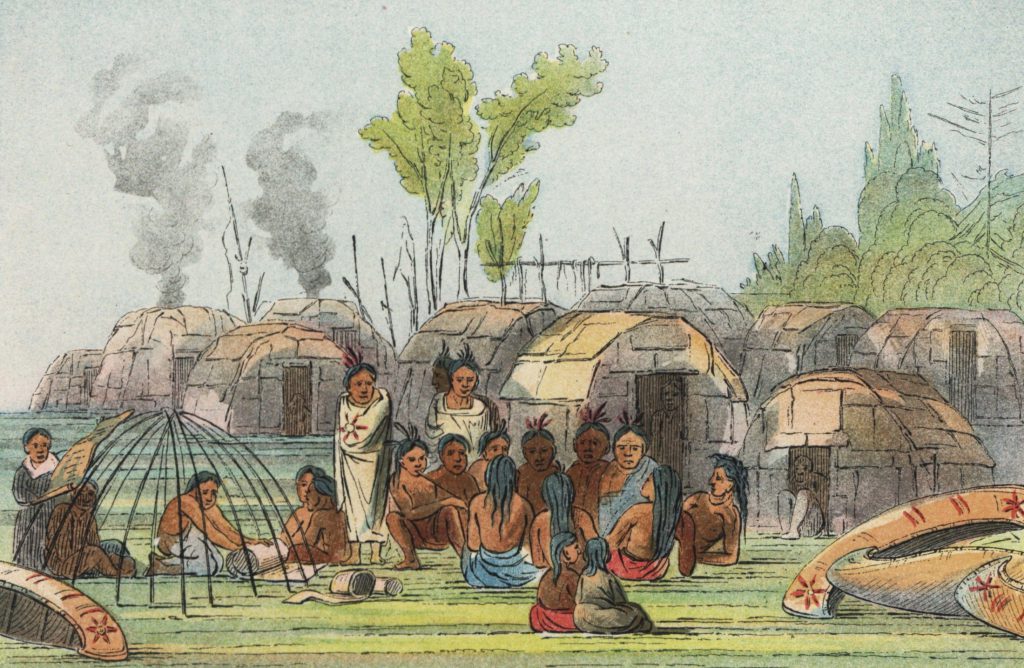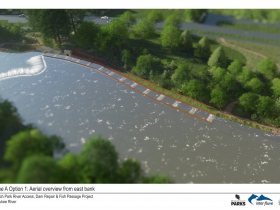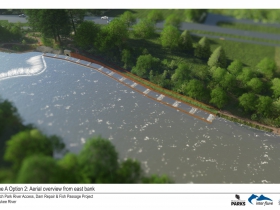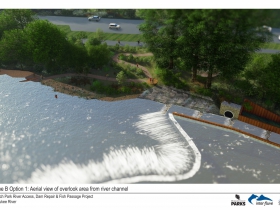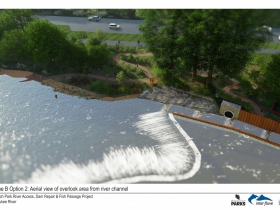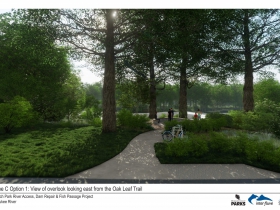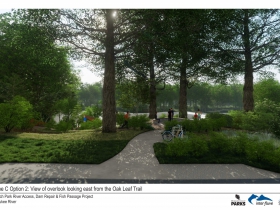County Officials Want to Pave Paradise
Why Kletzsch Park riverside is a sacred place with Native American history that must be saved.
You don’t know what you’ve got
Till it’s gone
They paved paradise
And put up a parking lot
–Joni Mitchell
The latest Milwaukee County Parks plan for Kletzsch Park fish passage, access, and overlook is an okay plan—for an ordinary place. But Kletzsch Park is no ordinary place.
In Kletzsch Park there are remnants of paradise, remnants of Indian Prairie.
The county plan is for a long canoe ramp. Walkways trucks can drive on. Paved fishing platforms. A roadway for maintenance and crane to access the fish ladder. A roadway they call a “path.” Really? What the world needs now is more pavement?
We come to the Kletzsch Park dam to step away from the hard-surfaced city, away from manicured suburb, to step off city surfaces to stand in the wild-feeling shelter of the great oak trees within the sound of the river. You don’t know what you’ve got till it’s gone. When the hard-edged fish ladder dominates the view, when we step from paved street to paved walkway to the hard surface of an platform overlook beneath dying oak trees, what we came here for will be gone. They paved paradise and put up an overlook.
Not so long ago, before 1850, Menomini people lived in bark-lodge villages just north of here. This area was and still is a sacred and ceremonial place for Indian people. And because much of the feeling of the place remains, we who are not Indian respond — even at the constructed dam — as to a sacred place. People still come here for ceremonies: We gather for wedding photos. We walk down to the water to be baptized. We scatter the ashes of our dead. We come to be quiet and alone. We come to meet a loved one.
We come here bringing the ones we love—some in wheelchairs or using walkers–because we can be together in this most peaceful wild-feeling site. Pavement and hardscape might make the river bank more accessible, but what we have come here for—the wild-feeling place—will have disappeared. The sacred and ceremonial feel of the place will have been “improved” away.
Remnants of Indian Prairie and the feeling of this sacred and ceremonial place remain today. To Indian people whose land all of this was, Kletzsch Park/Indian Prairie was and still is a special place. In Indian Prairie, and at two other places in the Milwaukee River watershed, early inhabitants constructed pairs of huge cross mounds. Four great intaglio effigies found no where else in the world were constructed in Indian Prairie. Native people came down the Milwaukee River in canoes, past nearby spirit trees, arriving at a now-buried spring which still flows.
In 1850 Menomini people lived in villages near today’s Good Hope Island. Through periodic burning, they maintained the oak savanna, remnants of which still exist as the bur oaks along the river. They came here to build conical mounds from the varied and rare soils still found in Kletzsch Park. They came to tend garden beds of which traces still exist. They forded the river in the shallows at Good Hope Island. They tended fish traps in the river. They witnessed sturgeon spawning in the shallows. A morning’s walk away were the berries of the lake shore forest, the wild rice beds of the river mouths, and myriad ducks and geese.
Though the county-led Kletzsch Park project team is trying to improve river health and access — and these are worthy goals —they are ignoring the feel of the place and the history of the place. They don’t know what they’ve got and they won’t till it’s gone. Just as good medicine strives to treat the whole being without causing harm, so should fish passage promote the area’s whole complex ecology without harming the trees and the bank.
We are only beginning to know what we have in Kletzsch Park/Indian Prairie. Let’s not “pave paradise” and then regret what we’ve lost when it’s irreplaceably gone.
To Take Action: On Thursday, December 19 at 8:45 am in Milwaukee County Courthouse Room 203R, the Parks, Environment and Energy Committee will meet to consider again the postponed vote on the County Park’s Kletzsch Park dam project. If you oppose this project, as we do, please send an email to the following by the time of the meeting:
| Felesia Martin | Supervisor | felesia.martin@milwaukeecountywi.gov |
| Jason Haas | Chairperson | jason.haas@Milwaukeecountywi.gov |
| Marcelia Nicholson | Supervisor | Marcelia.Nicholson@milwaukeecountywi.gov |
| Sheldon Wasserman | Vice Chair | Sheldon.Wasserman@milwaukeecountywi.gov |
| Steven Shea | Supervisor | steven.shea@milwaukeecountywi.gov |
Renderings
More about the Kletzsch Dam Fish Passage Plan
- Op Ed: County Officials Want to Pave Paradise - Martha Bergland - Dec 18th, 2019
- Op Ed: County’s Fish Passage Plan Seems Fishy - Karl Gartung - Dec 16th, 2019
- Op Ed: Let the Fish Run Free - Milwaukee Riverkeeper - Dec 3rd, 2019
- Op Ed: Save the Kletzsch Park Trees! - Martha Bergland - Apr 19th, 2019
Read more about Kletzsch Dam Fish Passage Plan here
Op-Ed
-
Unlocking Milwaukee’s Potential Through Smart Zoning Reform
 Jul 5th, 2024 by Ariam Kesete
Jul 5th, 2024 by Ariam Kesete
-
We Energies’ Natural Gas Plans Are A Mistake
 Jun 28th, 2024 by John Imes
Jun 28th, 2024 by John Imes
-
Milwaukee Needs New Kind of School Board
 Jun 26th, 2024 by Jordan Morales
Jun 26th, 2024 by Jordan Morales

